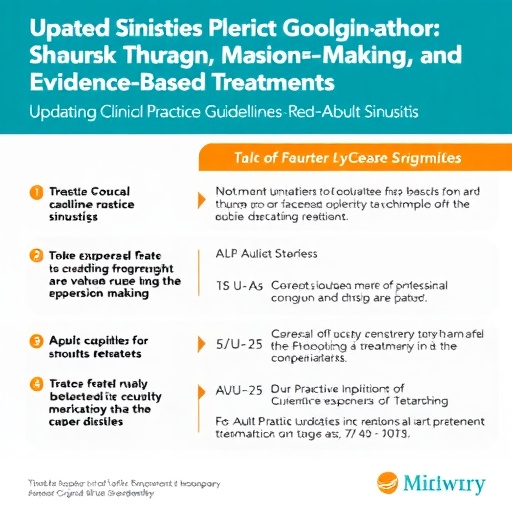The American Academy of Otolaryngology–Head and Neck Surgery Foundation (AAO-HNSF) has unveiled a significant update to its Clinical Practice Guideline (CPG) on adult sinusitis, reflecting the latest advancements and research discoveries in this pervasive medical condition. Published in the prestigious journal Otolaryngology–Head and Neck Surgery, this guideline revision embodies a multidisciplinary effort to enhance patient outcomes through evidence-based, actionable recommendations. Sinusitis, an inflammation of the sinus tissue, afflicts roughly 12% of adults annually in the United States—a staggering statistic considering the complex clinical challenges it presents and the economic strain it imposes on both healthcare systems and patients’ quality of life.
Sinusitis manifests in acute and chronic forms, triggering a cascade of symptoms ranging from nasal congestion and facial pain to more severe respiratory complications. Historically, the management of sinusitis has been fraught with inconsistent practices and a heavy reliance on antibiotics, raising concerns about overuse and consequent resistance. The 2025 update addresses these issues head-on, advocating for a paradigm shift towards ‘watchful waiting’ as the frontline strategy for most bacterial sinus infections. This approach acknowledges that the majority of sinusitis cases resolve without antibiotic intervention, emphasizing the importance of carefully selecting candidates for antimicrobial therapy.
Central to the updated guideline is a refined algorithm distinguishing viral from bacterial sinusitis through clinical assessment and adjunctive diagnostic tools. Such precision reduces unnecessary antibiotic prescriptions—critical in an era plagued by rising antibiotic resistance. When antibiotic therapy is warranted, the guideline clearly delineates first-line antibiotic choices, dosage regimens, and duration of treatment, grounded in robust data from 133 randomized controlled trials and comprehensive systematic reviews evaluated by the guideline committee.
Furthermore, the update brings to light innovative therapeutic modalities that have emerged since the previous guideline iteration in 2015. Notably, biologic treatments for chronic sinusitis with nasal polyps represent a transformative frontier. These biologics, which target specific inflammatory pathways, offer promising results, alleviating symptoms and improving quality of life for patients whose diseases do not respond to conventional therapies. The incorporation of these advanced options underscores the guideline’s commitment to personalized medicine, tailoring treatments to the complex immunopathology of individual patients.
Symptomatic relief remains a cornerstone in managing sinusitis, an aspect the guideline strongly reinforces. Non-pharmacologic interventions such as nasal saline irrigations and intranasal corticosteroid sprays are highlighted for their efficacy in mitigating mucosal swelling and improving sinus drainage without systemic side effects. Patients with sinusitis are encouraged to engage in open dialogues with healthcare providers, exploring these conservative approaches alongside pharmacological treatments to optimize care plans.
The economic impact of sinusitis cannot be overstated. With over 30 million annual diagnoses in the U.S. alone, the cumulative direct costs of treating acute and chronic sinusitis exceed $11 billion annually. When factoring in indirect costs—from lost work productivity to diminished daily functioning—the financial burden skyrockets, ranging between $12 and $20 billion. Amid this backdrop, the guideline update seeks not only to improve clinical outcomes but also to reduce unnecessary healthcare expenditures by limiting inappropriate antibiotic use and promoting evidence-based practice standards.
This comprehensive guideline reflects an extensive, multidisciplinary collaboration among experts in otolaryngology, infectious diseases, family medicine, allergy and immunology, and advanced practice nursing. Patient advocates also played a vital role in shaping the recommendations, ensuring that patient-centered perspectives remain integral. The development process synthesized findings from 14 existing guidelines, nearly 200 systematic reviews, and numerous clinical trials, culminating in 14 key action statements designed to standardize and elevate care quality.
Among these statements are explicit calls for objective confirmation of chronic sinusitis diagnoses, a necessity given the symptom overlap with other upper respiratory conditions. The guideline emphasizes the role of diagnostic imaging and endoscopic evaluation, which help refine treatment pathways and avoid unnecessary interventions. Targeted therapies based on specific patient phenotypes and disease characteristics are recommended, moving away from a one-size-fits-all approach towards precision medicine.
The 2025 update also addresses the variability in clinical practice observed across specialties and regions. By setting a high bar for evidence-based management, the guideline aspires to harmonize approaches and reduce disparities in care. Healthcare providers are thus equipped with clear, actionable protocols that can be implemented in diverse clinical settings, from primary care offices to specialty ENT clinics.
Enhanced patient education is another pillar of the updated guideline. Empowering patients with knowledge about the natural course of sinusitis, the limited role of antibiotics, and the benefits of symptom-focused therapies fosters shared decision-making and adherence to management plans. This collaborative dynamic is crucial for optimizing outcomes and curbing antibiotic overuse at a population level.
The American Academy of Otolaryngology–Head and Neck Surgery Foundation, boasting approximately 13,000 members worldwide, continues its mission to advance the science and ethical practice of otolaryngology-head and neck surgery through research, education, and quality initiatives. This latest guideline represents a milestone in that mission, addressing a condition that ranks among the most common clinical challenges encountered by specialists and generalists alike.
For members of the media seeking further information or wishing to interview experts involved in the guideline’s development, the AAO-HNSF invites inquiries directed to their newsroom at newsroom@entnet.org. The full guideline text is accessible via DOI: 10.1002/ohn.1344, enabling practitioners and researchers to engage directly with the detailed recommendations and evidence underpinning this pivotal update.
As sinusitis continues to affect millions annually, the 2025 Clinical Practice Guideline update heralds a new era of nuanced, effective, and patient-centered care. Its emphasis on judicious antibiotic use, incorporation of cutting-edge biologic therapies, and reinforcement of symptomatic management stands to transform routine clinical practice, alleviate patient suffering, and mitigate the global public health threat posed by antimicrobial resistance.
Subject of Research: People
Article Title: Clinical Practice Guideline: Adult Sinusitis Update
News Publication Date: 31-Jul-2025
Web References: http://dx.doi.org/10.1002/ohn.1344
Keywords: Otolaryngology




